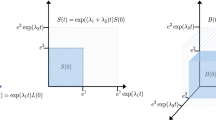Abstract
This paper proposes an efficient algorithm for simultaneous reduction of three matrices by using orthogonal transformations, where \(A\) is reduced to \(m\)-Hessenberg form, and \(B\) and \(E\) to triangular form. The algorithm is a blocked version of the algorithm described by Miminis and Paige (Int J Control 35:341–354, 1982). The \(m\)-Hessenberg-triangular–triangular form of matrices \(A\), \(B\) and \(E\) is specially suitable for solving multiple shifted systems \((\sigma E-A)X=B\). Such shifted systems naturally occur in control theory when evaluating the transfer function of a descriptor system, or in interpolatory model reduction methods. They also arise as a result of discretizing the time-harmonic wave equation in heterogeneous media, or originate from structural dynamics engineering problems. The proposed blocked algorithm for the \(m\)-Hessenberg-triangular-triangular reduction is based on aggregated Givens rotations, and is a generalization of the blocked algorithm for the Hessenberg-triangular reduction proposed by Kågström et al. (BIT 48:563–584, 2008). Numerical tests confirm that the blocked algorithm is much faster than its non-blocked version based on regular Givens rotations only. As an illustration of its efficiency, two applications of the \(m\)-Hessenberg-triangular-triangular reduction from control theory are described: evaluation of the transfer function of a descriptor system at many complex values, and computation of the staircase form used to identify the controllable part of the system.















Similar content being viewed by others
References
Ahuja, K., De Sturler, E., Gugercin, S., Chang, E.R.: Recycling BiCG with an application to model reduction. SIAM J. Sci. Comput. 34, A1925–A1949 (2012)
Anderson, E., Bai, Z., Bischof, C., Blackford, S., Demmel, J., Dongarra, J.J., Du Croz, J., Greenbaum, A., Hammarling, S.J., McKenney, A., Sorensen, D.C.: LAPACK Users’ Guide, 3rd edn. SIAM, Philadelphia (1999)
Beattie, C.A., Drmač, Z., Gugercin, S.: A note on shifted Hessenberg systems and frequency response computation. ACM Trans. Math. Softw. 38, 12:1–12:16 (2011)
Bosner, N., Bujanović, Z., Drmač, Z.: Efficient generalized Hessenberg form and applications. ACM Trans. Math. Softw. 39, 19:1–19:19 (2013)
Chu, K.-W.E.: A controllability condensed form and a state feedback pole assignment algorithm for descriptor systems. IEEE Trans. Autom. Control 33, 366–370 (1988)
Dackland, K., Kågström, B.: Blocked algorithms and software for reduction of a regular matrix pair to generalized Schur form. ACM Trans. Math. Softw. 25, 425–454 (1999)
Dongarra, J.J., Du Croz, J., Duff, I., Hammarling, S.: A set of Level 3 basic linear algebra subprograms. ACM Trans. Math. Soft. 16, 1–17 (1990)
Golub, G.H., van Loan, C.F.: Matrix Computations, 3rd edn. M. D. Johns Hopkins University Press, Baltimore (1996)
Gugercin, S., Antoulas, A.C., Beattie, C.A.: H2 model reduction for large-scale linear dynamical systems. SIAM J. Matrix Anal. Appl. 30, 609–638 (2008)
Higham, N.J.: Accuracy and Stability of Numerical Algorithms, 2nd edn. SIAM, Philadelphia (2002)
Kågström, B., Kressner, D., Quintana-Ortí, E.S., Quintana-Ortí, G.: Blocked algorithms for the reduction to Hessenberg-triangular form revisited. BIT 48, 563–584 (2008)
Karlsson, L., Kågström, B.: Parallel two-stage reduction to Hessenberg form using dynamic scheduling on shared-memory architectures. Parallel Comput. 37, 771–782 (2011)
Lang, B.: Using level 3 BLAS in rotation-based algorithms. SIAM J. Sci. Comput. 19, 626–634 (1998)
Laub, A.J., Linnemann, A.: Hessenberg and Hessenberg/triangular forms in linear system theory. Int. J. Control 44, 1523–1547 (1986)
Miminis, G.S.: Deflation in eigenvalue assignment of descriptor systems using state feedback. IEEE Trans. Autom. Control 38, 1322–1336 (1993)
Miminis, G.S., Paige, C.C.: An algorithm for pole assignment of time invariant linear systems. Int. J. Control 35, 341–354 (1982)
Miminis, G.S., Paige, C.C.: An algorithm for pole assignment of time invariant multi-input linear systems. In: Proceedings 21st IEEE Conference on Decision and Control, pp. 62–67 (1982)
Paige, C.C.: Properties of numerical algorithms related to computing controllability. IEEE Trans. Autom. Control 26, 130–138 (1981)
Parallelism in the Intel\(\textregistered {}\) Math Kernel Library. http://software.intel.com/en-us/articles/parallelism-in-the-intel-math-kernel-library
Simoncini, V.: Restarted full orthogonalization method for shifted linear systems. BIT 43, 459–466 (2003)
Simoncini, V., Perotti, F.: On the numerical solution of \((\lambda ^{2}A+\lambda B+C)x=b\) and application to structural dynamics. SIAM J. Sci. Comput. 23, 1875–1897 (2002)
SLICOT. http://www.slicot.org
van Dooren, P.M., Verhaegen, M.: On the use of unitary state-space transformations, Linear algebra and its role in systems theory, Proc. AMS-IMS-SIAM Conf., Brunswick/Maine 1984. Contemp. Math. 47, 447–463 (1985)
van Gijzen, M.B., Erlangga, Y.A., Vuik, C.: Spectral analysis of the discrete Helmholtz operator preconditioned with a shifted Laplacian. SIAM J. Sci. Comput. 29, 1942–1958 (2007)
Van Zee, F.G., van de Geijn, R.A., Quintana-Orti, G.: Restructuring the tridiagonal and bidiagonal QR algorithms for performance. ACM Trans. Math. Softw. 40, 18:1–18:34 (2014)
Varga, A.: Numerical algorithms and software tools for analysis and modelling of descriptor systems. Prepr. of 2nd IFAC Workshop on System Structure and Control, Prague, pp. 392–395 (1992)
Varga, A.: Computation of irreducible generalized state-space realizations. Kybernetika 26, 89–106 (1990)
Varga, A., Van Dooren, P.M.: Task I.A—basic software tools for standard and generalized state-space systems and transfer matrix factorizations, SLICOT Working Note 17 (1999)
Acknowledgments
The author wishes to thank the referees for giving many helpful suggestions, which inspired the development of the double-blocked algorithm for the \(m\)-Hessenberg-triangular-triangular reduction, and helped to improve the quality of the paper.
Author information
Authors and Affiliations
Corresponding author
Additional information
Communicated by Daniel Kressner.
Rights and permissions
About this article
Cite this article
Bosner, N. Efficient algorithm for simultaneous reduction to the \(m\)-Hessenberg-triangular-triangular form. Bit Numer Math 55, 677–703 (2015). https://doi.org/10.1007/s10543-014-0516-y
Received:
Accepted:
Published:
Issue Date:
DOI: https://doi.org/10.1007/s10543-014-0516-y
Keywords
- \(m\)-Hessenberg-triangular-triangular form
- Orthogonal transformations
- Level 3 BLAS
- Blocked algorithm
- Solving shifted system
- Transfer function evaluation
- Staircase form




